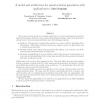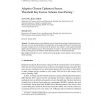119 search results - page 14 / 24 » Finite models for formal security proofs |
SP
1998
IEEE
13 years 11 months ago
1998
IEEE
A strand is a sequence of events; it represents either the execution of legitimate party in a security protocol or else a sequence of actions by a penetrator. A strand space is a ...
FAC
2008
13 years 7 months ago
2008
Ten years ago the Mondex electronic purse was certified to ITSEC Level E6, the highest level of assuranceforsecuresystems.ThisinvolvedbuildingformalmodelsintheZnotation,linkingthem...
CCS
2005
ACM
14 years 1 months ago
2005
ACM
We present a formal model and a simple architecture for robust pseudorandom generation that ensures resilience in the face of an observer with partial knowledge/control of the gen...
INFORMATICALT
2006
13 years 7 months ago
2006
This paper proposes a threshold key escrow scheme from pairing. It tolerates the passive adversary to access any internal data of corrupted key escrow agents and the active adversa...
LICS
1999
IEEE
13 years 11 months ago
1999
IEEE
Security protocols use cryptography to set up private communication channels on an insecure network. Many protocols contain flaws, and because security goals are seldom specified ...


